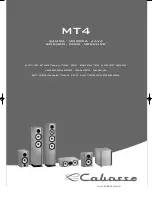
iP Series Loudspe
ak
ers
10
iP Series Loudspeakers
A protection circuit is built into the iP-10, iP-12
and iP-15 to protect their high-frequency drivers from
excessive power. When tripped, the protection circuit
substantially reduces the power to the HF driver. After
the driver cools to a safe operating temperature, the
protection circuit resets and normal operation resumes.
However,
if the protection circuit senses excessive power,
it will trip again. In this case, it is necessary to reduce
the power to the loudspeaker by either turning down the
gain controls on the power amplifier or turning down
the master volume control on the mixer or other sound
source.
CAUTION:
The protection circuit is designed
to protect the HF driver under reasonable
and sensible conditions. Should you choose
to ignore the warning signs (i.e., frequent clip LED
indications on the mixer or power amplifier, excessive
distortion), you can still damage the drivers in the iP
Series loudspeakers by overdriving them past their
recommended amplifier power-handling ratings, or past
the point of amplifier clipping. Such damage is beyond the
scope of the warranty.
Amplifier Power
The iP Series loudspeakers have three power-
handling numbers: continuous, program and peak.
So how much power do you really need to drive these
loudspeakers? The answer to that question depends on
what type of program material you are running through
the system and how loud it needs to be.
Some audio signals have lots of momentary peaks
whose amplitudes extend far above the average overall
level of the program. Percussion instruments are a
good example of this. Other types of signals, like highly
compressed rock music, have a higher average signal
level with fewer peaks. Speech reinforcement requires
less power overall, but involves large moment-to-
moment variations in level.
Assuming you want to use the full capability of the
loudspeaker, and the program contains at least some
momentary peaks, we recommend that you use an
amplifier that is rated at twice the continuous power
rating of the loudspeaker (into 8 ohms). For the iP-10
loudspeakers, this would be 200 watts × 2 = 400 watts
per channel into 8 ohms. This ensures that the amplifier
can reproduce peaks that are 6 dB higher than the
continuous (rms) power-handling rating before clipping
occurs.
Protection
Recommended Power Ratings
• iP-10: 400 watts into 8 ohms (200 watts rms × 2)
• iP-12: 500 watts into 4 ohms (300 watts rms × 2)
• iP-15: 600 watts into 8 ohms (300 watts rms × 2)
• iP-18S: 800 watts into 8 ohms (400 watts rms × 2)
Preventing Loudspeaker Damage
Speaking of clipping, this is likely the number one
cause of damage to loudspeakers. Clipping occurs when
the signal at the output of any device in the system
(not just the amplifier) reaches its maximum level. The
input signal to the device may continue to increase, but
the output simply stops, and is characterized by a “flat-
top” appearance to the waveform.
Clipping interrupts the motion of the transducer,
creating distortion and excessive heat in the driver,
which can damage it over time.
Some folks think that if they use a power amplifier
whose power rating is below the maximum power-
handling rating of the loudspeaker, then they can’t
possibly damage the loudspeaker. But if the amplifier is
driven into clipping, even a lower power amplifier can
damage the loudspeaker.
The bottom line is that to prevent damage to the
loudspeakers, you must have a properly operating sound
system. Proper operation of a sound system includes
being aware of types of audio signals being reproduced,
controlling the output levels accordingly, and operating
all the devices in the system so that no clipping occurs
within the signal chain.
Normal Sine Wave Signal
Clipped Sine Wave Signal

































